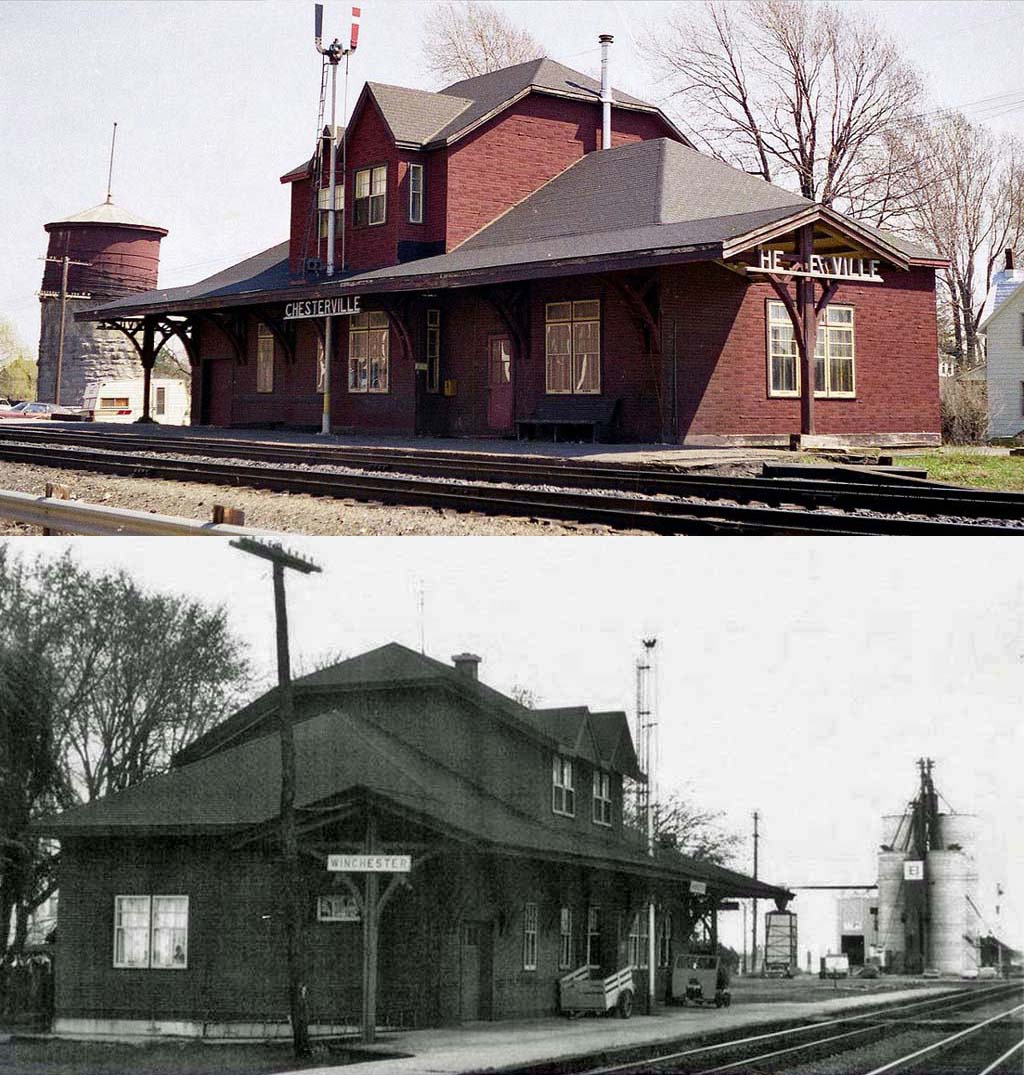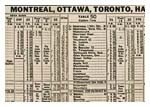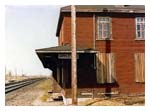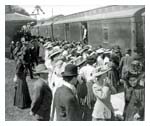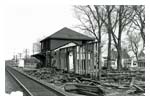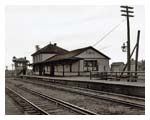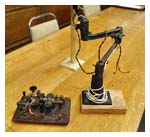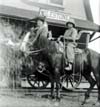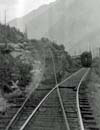 | Canadian Pacific Odds and Ends - Part 13 Articles |
| Notes - CR&MW The CP 8560 Project - Anonymous Author RDC Steam Lines - Bruce Chapman Telegraphing - Richard Inwood Toasters - Andy Cassidy Tree Windbreaks - CR&MW Through the United Counties - Craig Stevenson Charles Jasper Glidden - Anonymous Author OKthePK's website "Last Call" page has appeared weekly over the past few years. Each week a different article told the story of various railway items of interest. While some of the articles were saved they are no longer available online. Many of those about the Canadian Pacific Railway have been compiled here on this page. There is insufficient room to display more than a few Last Call articles per page. As a result, "Canadian Pacific Odds and Ends - Part 13", continues this month with more possible parts to follow as time passes. 
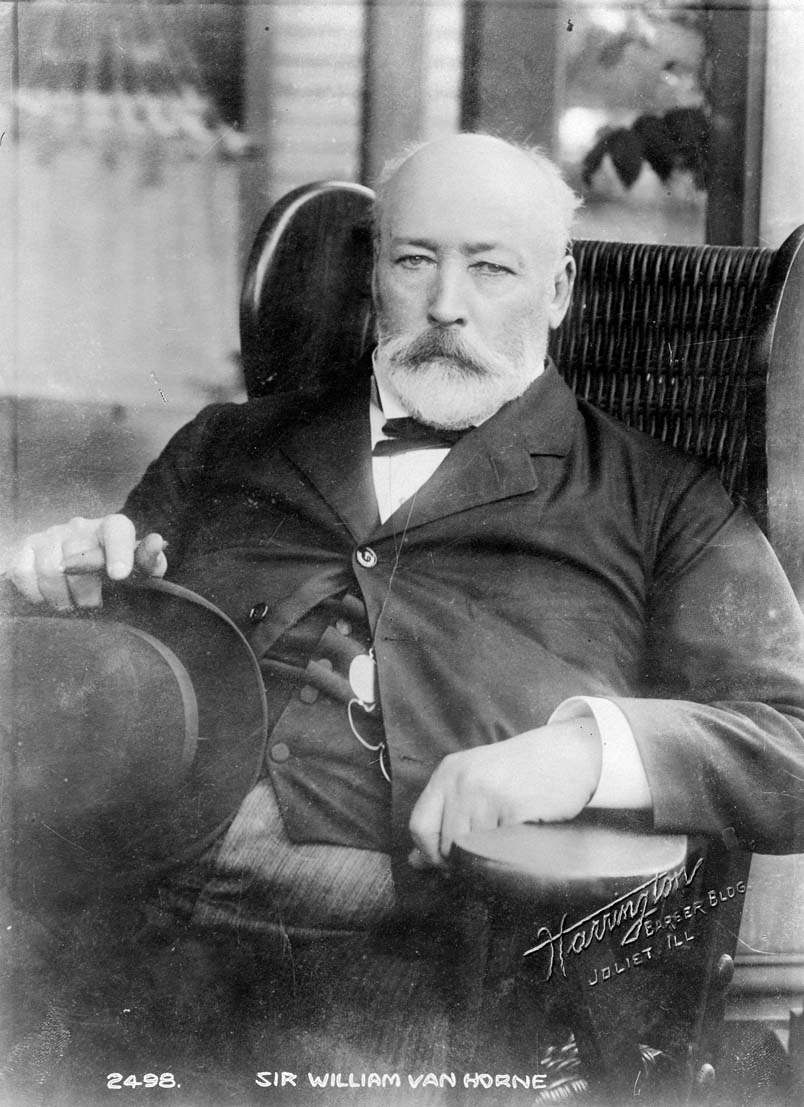 Sir William Van Horne - Date? Photographer? Sir William Van Horne's Estate - The Supreme Court at Ottawa recently heard the case of the British Columbia Finance Minister vs. Royal Trust Company, an appeal from the judgment of the British Columbia Court of Appeals affirming the judgment of the trial judge, which declared that the Finance Minister's statement determining the amount of succession duty in respect to the estate of the late Sir Wm. Van Horne payable to the Province of British Columbia proceeded upon an erroneous basis, and that the succession duty payable in respect of such estate to British Columbia is $8,523.16 and no more. The appellant's grounds of appeal were that the property of the deceased, wherever situated, should be taken into account in determining the rate of succession duty to which the property of deceased situate within British Columbia is liable and that the part of deceased's property within the province is liable to the proportionate duty that would have been payable by that portion if all the property of deceased, wherever situate, had been within the province. Judgment was reserved. C.P.R. Special Farming Train - The C.P.R., in connection with the Saskatchewan Agriculture and Education Departments, and Saskatchewan University College, provided a special train of 13 lecture and demonstration cars to travel over the Saskatchewan lines and give instruction on the raising of live stock, field husbandry, poultry raising, farm mechanics, household science, and instruction for boys and girls. The first stopping place was Macklin, on 31 May 1920, and the trip was timed to end at Yorkton, 19 Jun 1920. The schedule provided that two centers were to be visited each day, the period of instruction being four hours, from 9 a.m. to 1 p.m., and from 2:30 to 6:30 p.m. Fighting Grasshoppers - The C.P.R. has had poison spread along its right-of-way in the prairie provinces to kill grasshoppers in the infected areas. Joliette Freight Sheds Burned - The freight sheds at Joliette, Quebec, were destroyed by fire, together with seven cars and a quantity of freight on 10 Jul 1920, the total loss being estimated at $100,000. The passenger station was saved with difficulty. Sarnia, Ontario - In connection with the proposal made to the C.P.R. recently to build a line from near London to Sarnia a press report states that the company's officials have been favorably impressed with the proposal and will probably recommend its adoption. The report also states that one of the company's engineers has been over the ground following the recent trip of President E.W. Beatty and his party.  The CP 8560 Project Anonymous Author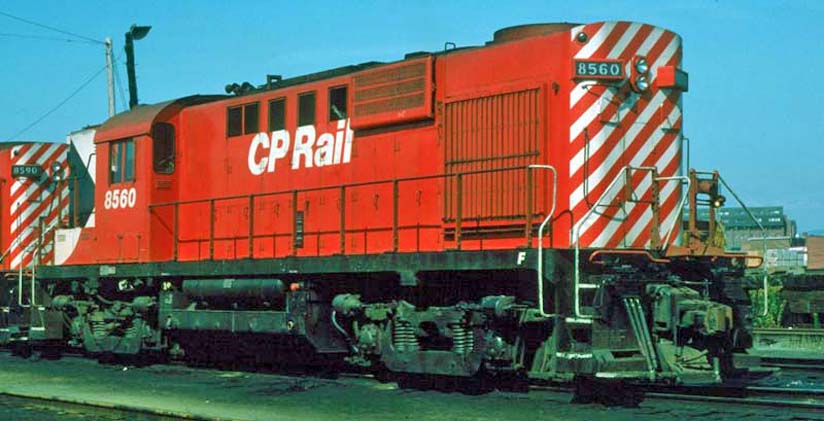 CP Rail RS10 number 8560 - Date? Photographer? - Dean Motis Collection. There are railfans, then there are Railfans! Santa delivered this recently sandblasted and primed piece of scrap metal to the Railfan's garage door just before Christmas, 2020. 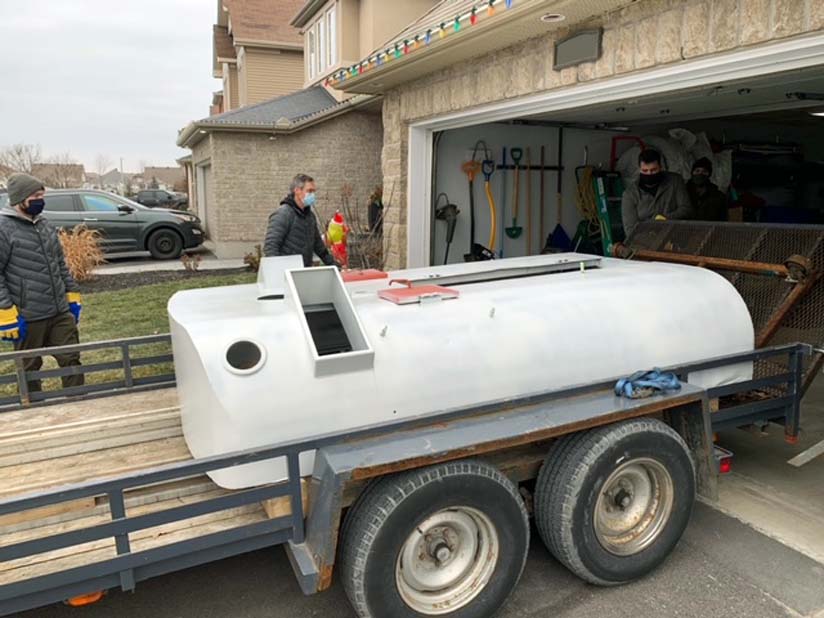 A special delivery... do you recognize it? - Date? Photographer? It's the last vestige of Canadian Pacific Railway model RS10 diesel-electric locomotive number 8560. When the weather warms up in a few months it will be painted into 8560's last paint scheme, CP Rail with 5 stripes. A good friend restored all the light castings so the plan is to have them functional, hooked up to a motion sensor, so when the garage door is opened they will light up. 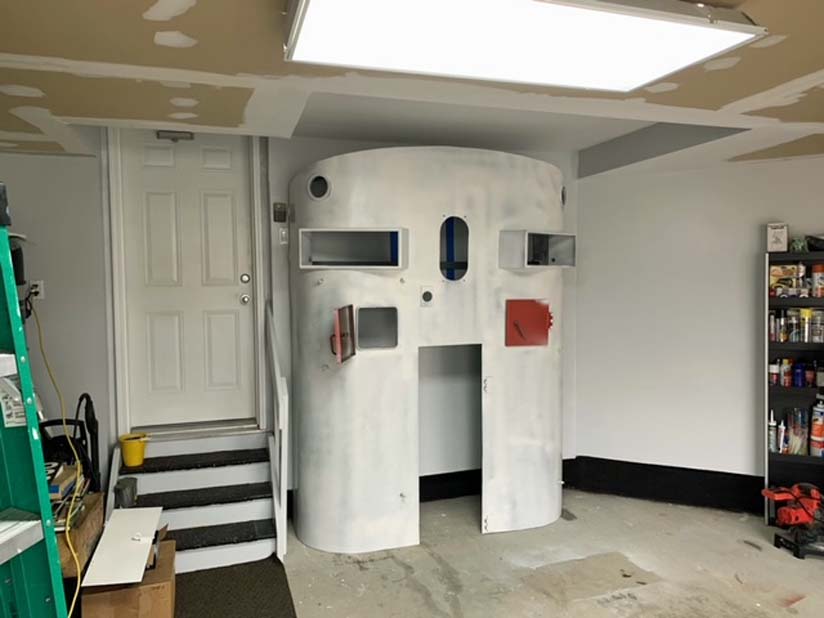 The nose of RS10 number 8560 upright inside the garage - Date? Photographer? The Railfan also has the bell, which presents intriguing possibilities... but his wife said no way!  RDC Steam Lines Bruce Chapman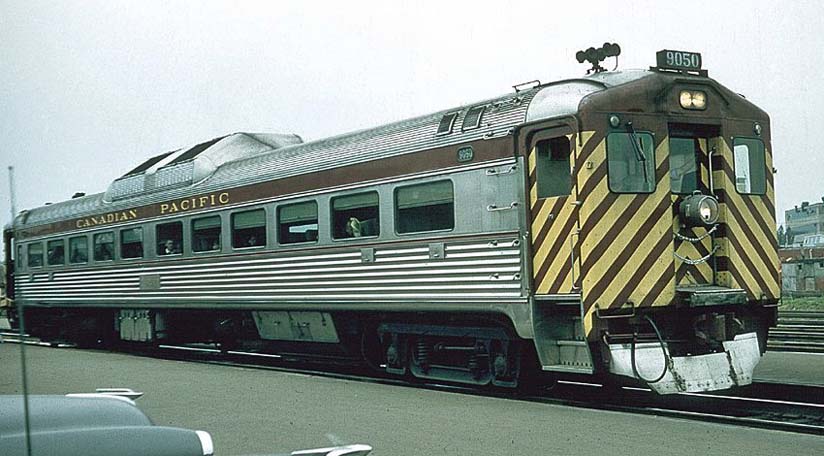 Rail Diesel Car (RDC) number 9050 - Date? Photographer? When the RDC's first came out, they were touted as being a train without a locomotive to haul them. CP was dieselizing at the time, and there were lots of local trains, some being handled by gas-electrics, like those on the Maniwaki Subdivision. On long weekends, the subdivisions receiving RDC's, like the Lachute and Ste. Agathe subdivisions would need more RDC's than available, so one set would go to one subdivision, and the other sub would get a conventional train with a steam locomotive, or diesel, and conventional coaches which were steam heated. Long weekends in Ottawa could see the Chalk River passenger train get a steam locomotive or diesel with baggage car and coach, with an RDC trailing which would continue on by itself from Chalk River to Temiscaming, and return in time for its move east to Ottawa the following day. Whether RDC's came from the plant in Pennsylvania with a through steam line is unknown by me, but if there was no through steam line, Angus shops in Montreal would add one before its first departure. When I went dispatching at Smiths Falls in January 1969, there were 2 dispatcher's desks, east Winchester, and North Chalk River. Each desk had several cubbyholes in front of the desk for booklets on dispatching, running trades rules, dispatcher's rules, and on and on. As I looked through them in quiet times, I noted a vast array of old tonnage booklets, long, long expired. The oldest one was from 1 Jul 1946 which was called "haulage capacity of locomotives in equivalent tons and instructions relating thereto". There was one on the east desk and one on the north desk. They gave locomotive classifications, driver size, capacity as a percentage, tender capacity, and weight. At the very bottom, it showed diesel switchers on hand as 7010 to 7051, with a wheel type of 4-0-4. Next booklet there was dated 1 Jan 1957. By this time, passenger trains were being dropped left and right. This booklet showed whether a diesel unit had a steam line running through it, and whether it was a passenger or freight unit. It didn't list RDC's, but the shops that handled them would have known of its capabilities. In this time frame, CP ordered as many diesels as it could with through steam lines. All the 1400, 1800, and 1900 diesel series had them as well as steam generator equipped units. All others had through steam lines except the FA1's and FA2's (without SG's), FB1-2 (without SG), yard units, Baldwins 8000 and 8005 to 8012, RS2's, first GP7 8409, and then 8412 to 8419 and that was it. Everything else had a through steam train line. 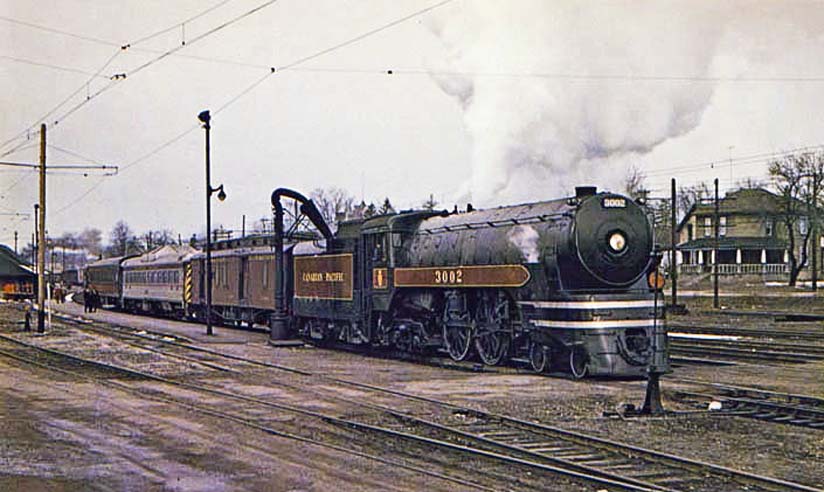 A local steam powered train with an RDC mid-train - Date? Photographer? When I went to Montreal in August of 1974 to the Power Bureau, many of the MLW's assigned to Montreal were supposed to have their steam lines intact, but we found out that if a unit had derailed, or been in a mishap where the steam connector was broken, it was just removed. We might get a notification of this downtown in Windsor Station, but in the future, which didn't help. So whenever I went to St. Luc, wandering around taking pictures, I would look underneath the unit to see which units still had intact steam train lines. The reason for this was we would run 2 trains daily to Saint John, New Brunswick, from St. Luc, trains number 952 and 908. However, westbound, often Saint John would barely have enough traffic to run one train on Sunday and Monday, just number 949, so 907 would not run. We were only allowed 5 units per train so if 952 and 908 both arrived in Saint John with 5 units each, we'd have 5 units left over, with more coming in. So we'd pile those 5 (or depending on the numbers left over) on train 41 behind an E8 to Montreal. And if train 949 on Sunday evening only needed 2 or 3 units for the tonnage required, we could have up to 7 freight units behind the E8 coming into Montreal on Monday morning. However, they all had to have intact steam lines, the units that had through steam lines, we'd put a blue dot on the magnetic tags that we used in the office to denote the units with the through steam lines that could come in as passenger service, and have Saint John shop put the units without through steam lines on train 949. So this poor shop guy could be chopping up units on a Sunday to get the right units on each train. By 1974, CP was actively trying to get rid of passenger trains like crazy, and putting lots of expenses into their reason for dropping passenger trains, so train 41 would pull into Windsor Station on Monday morning, right in the middle of all the commuter trains. All the commuters getting off their trains would see this passenger train pull in with 8 units and only 4 passenger cars and say, "Well, there's an overpowered passenger train. No wonder CP says they're losing money on passengers, well, it doesn't take a genius to figure out why they're losing money!" 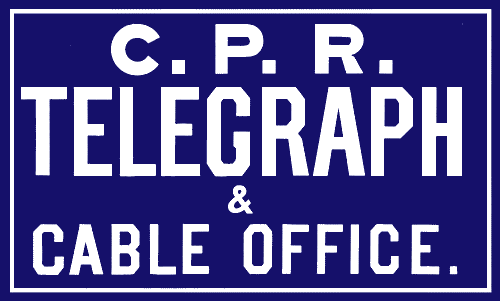 Telegraphing Richard Inwood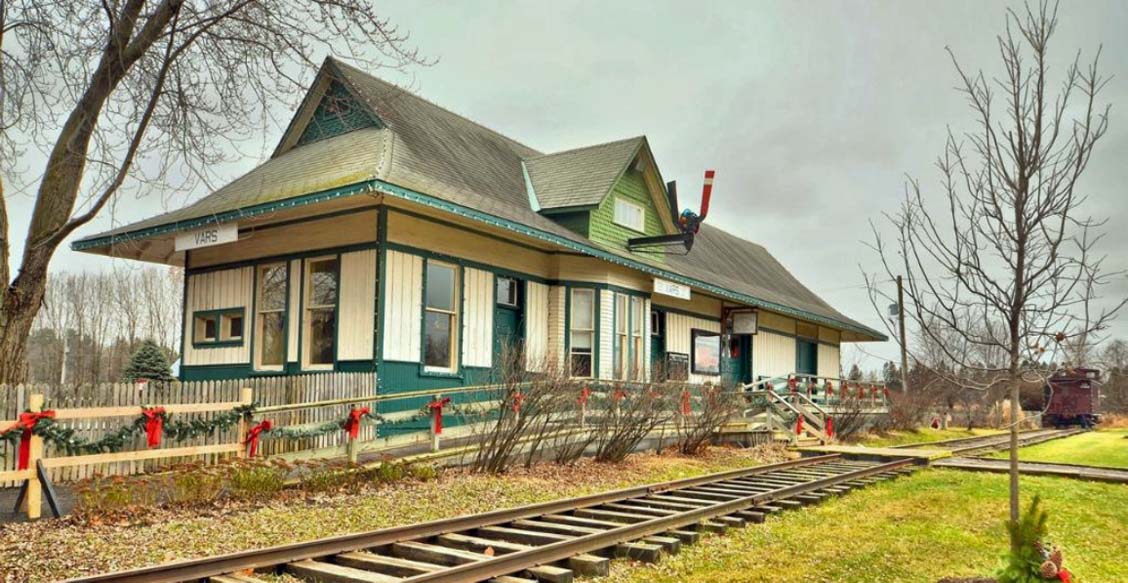 Canadian National Railways Vars station is now a museum - Date? Photographer? CN's old Vars railway station is now part of a heritage museum in the Ottawa suburb of Cumberland. The museum features a church, school-house, general store, blacksmith, firehall, sawmill, and scale-model working steam engines. The station at the museum entrance, along with the caboose just down the track, are prominent features. 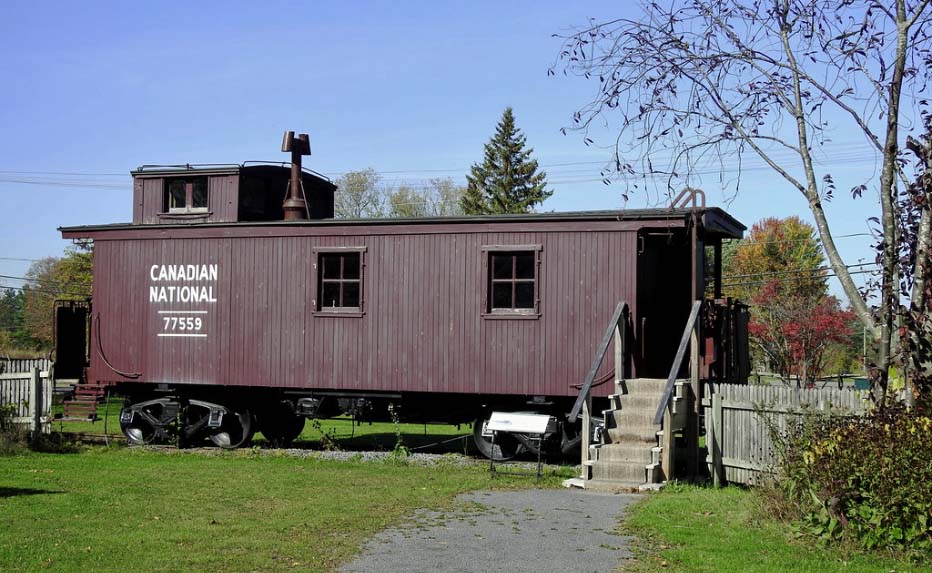 Ex-Canadian National caboose number 77559 at the Cumberland Museum - 18 Oct 2017 Photographer? As I worked as a Canadian Pacific Railway (CP) telegrapher back in the 1950's and still remember Morse code, the museum's directors call on me and a couple of my old railway buddies to perform telegraphy demonstrations, from time to time, on site.  Richard Inwood works a bug (a type of telegraph key) - Date? Photographer? One of us works in the station, while the other sets up in the caboose. People write messages in longhand and we transmit them in Morse code to the telegrapher at other end, who types out the message on a telegram blank for them to pick up. People get a big kick out of that. Young kids even get a kick out of the typewriters, we use. 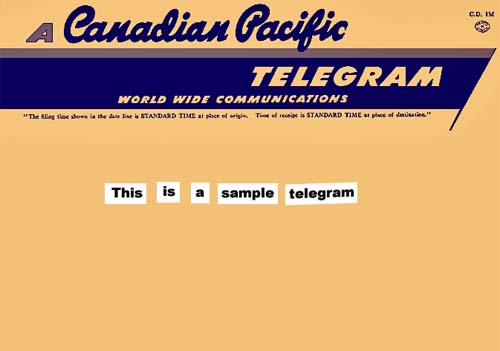 A sample telegram form. Station Agents Next to the local postmaster, the railway station agent was the most important and popular person in small town Canada, back in the 1930s, 1940s, and 1950s. With rare exceptions (including Vars) the agent lived upstairs (i.e. above the station). And they knew everyone in town, and everything that was going on. During WW II, for instance, it was they who had to deliver the sad news to the family that a son or daughter was missing or killed in action. This and other news came to them by telegraph. That skill was a must, although their job required them to perform many more duties. They had to provide information and sell tickets to passengers. They made sure that box cars, gondolas, or whatever, were available to shippers, when required, and when the time came, they drew up the bills-of-way and made sure those shipments were picked up by the local wayfreight. However, their most important job was to assure that train traffic was safe. 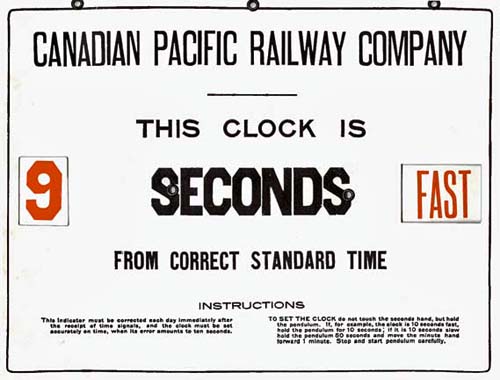 A station clock sign with clock setting instructions. Accurate timing was critical. Scheduled trains couldn't just depart whenever the crews felt like it. They had to respect the clock, that is, the railway station clock, which had to be accurate within seconds. This was accomplished by sending out a daily time signal to all stations on the telegraph network. Station agents would make sure their clocks were accurate. Conductors would match their pocket watches with those clocks, and later, match their watches with the engineers. The semaphore signal atop the station was a vital piece of equipment. Vars, like many more stations, was on a single track. That meant that trains, travelling in both directions, were using the track. How to keep them from plowing into each other? Well, that was the dispatcher's job (in Ottawa and later Belleville for CN, and in Smiths Falls for CP) and he needed the local station agents and other telegraph operators to relay train orders to the engineers and conductors of passing trains. The agent or mainline telegraph operator would first place the semaphore signal in the proper position and write out the dispatcher's instructions to train A to take the siding at a certain point to allow train B to pass. The orders were attached to a hoop, which was held up for the engineers and conductors to put their arms through. 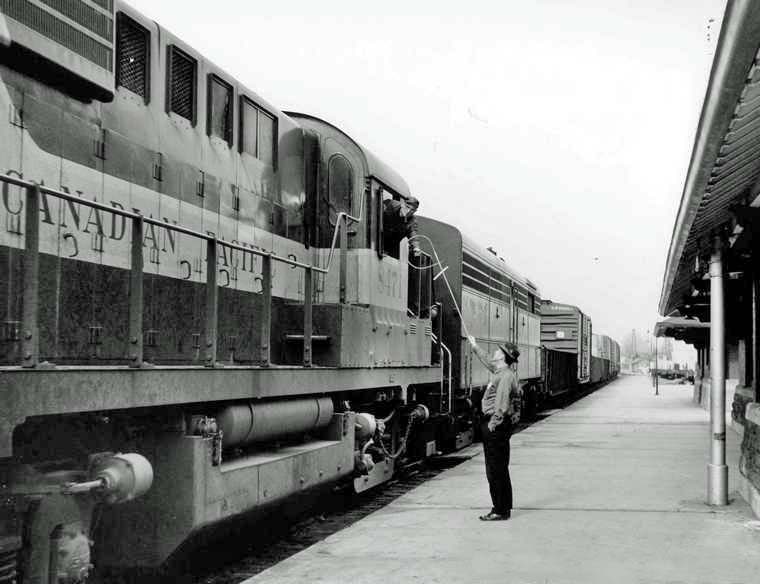 A station agent or operator hoops orders to CP 8471 at Woodstock - 1969 Bill Thomson. It sounds primitive, and maybe it was, but it was vital, and it worked.  Toasters Andy Cassidy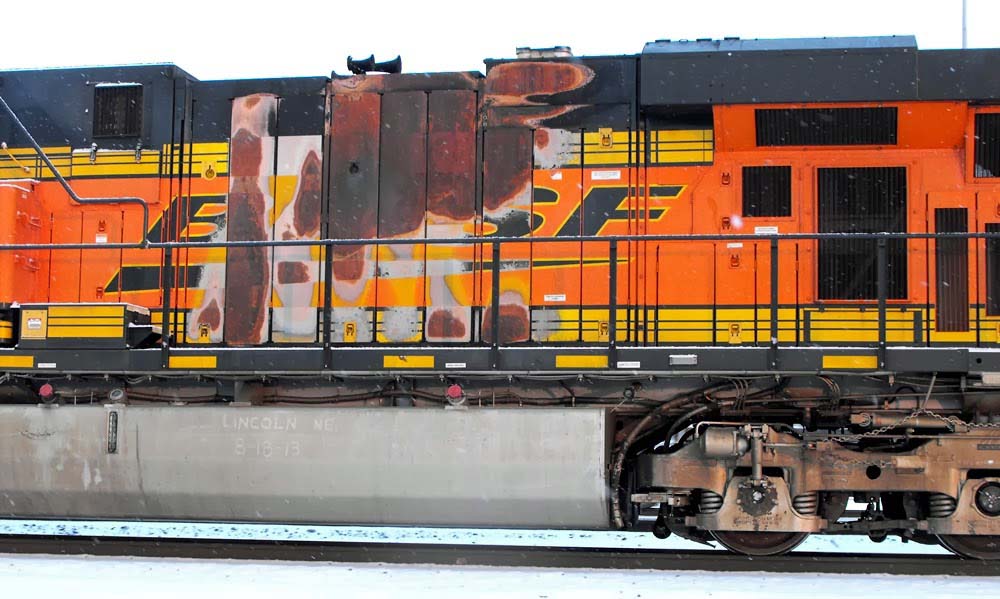 BNSF 6179 is what's known as a "Toaster" - 2013 Photographer? Some of you may have noticed a diesel-electric locomotive with a large blotch of damaged paint on the side of the unit. General Electric (GE) locomotives are only referred to as a "Toaster" after it's had a fire that burns the carbody paint leaving a big mess. They are not generally referred to as Toasters just because they're GE loco's. Okay, below is a standard GE 7FDL engine end view. 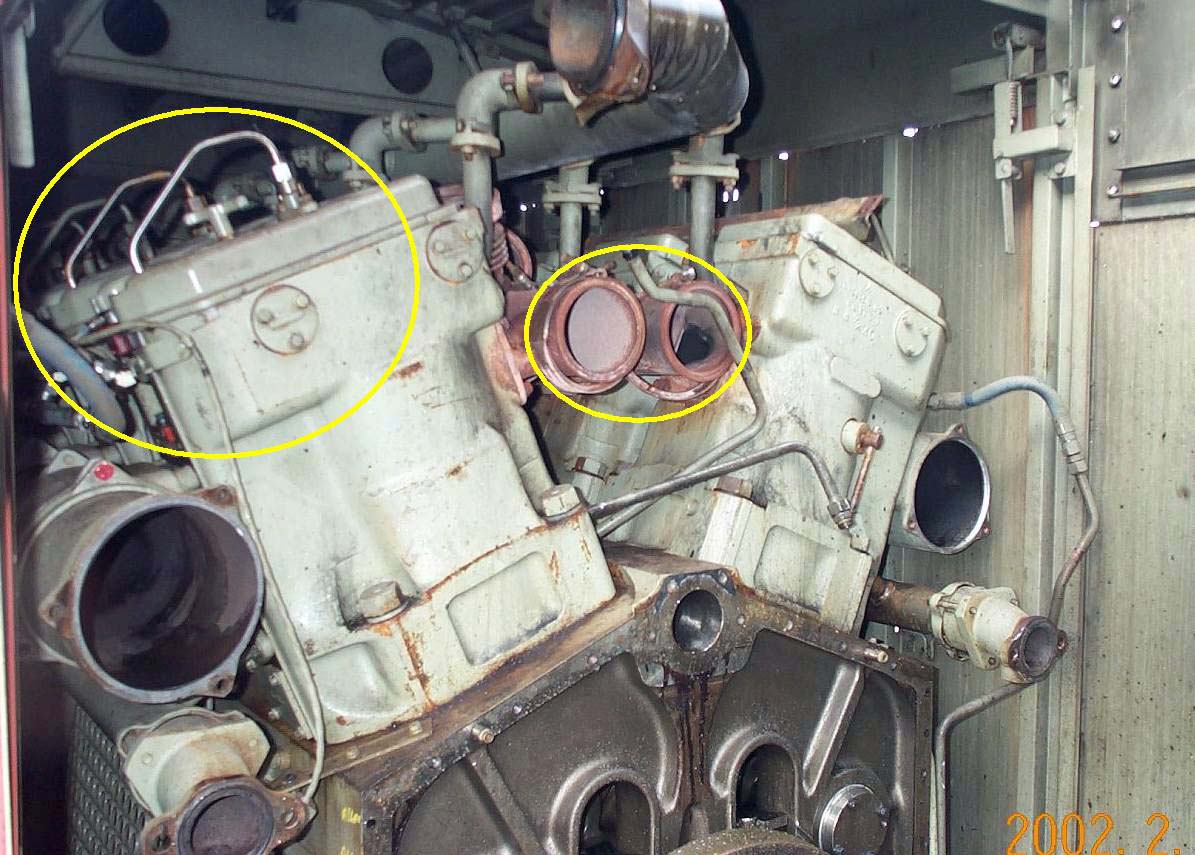 The General Electric 7FDL engine - Date? Andy Cassidy. The circle on the left shows the external high pressure (HP) fuel pump (sort of hidden in part of the head, see the red doo-dads), and the HP fuel line that runs up, over, and down into the top of the injector. The Hot exhaust manifold (middle circle), is in the middle of the "Vee". If a leak occurs it usually sprays all over due to the pressure, and the fumes or raw fuel will light up when it comes into contact with the manifold. Result... a Toaster. The newer General Electric locomotives using the EVO engine, as seen below, are quite different. 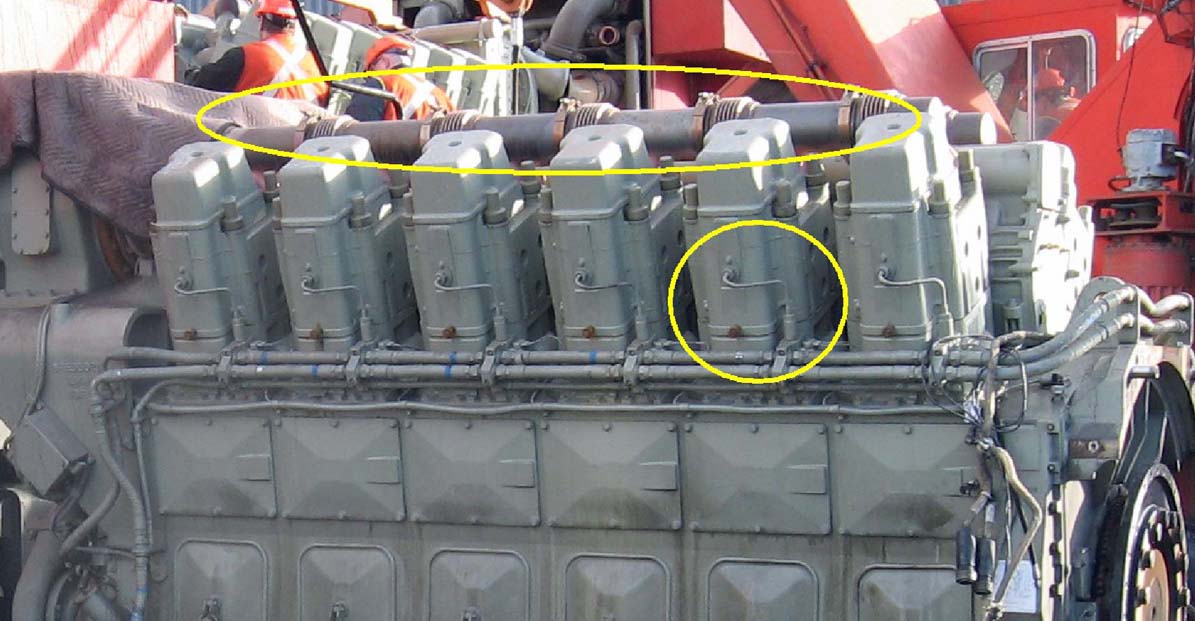 The newer General Electric EVO engine - Date? Andy Cassidy. First, they are V12 cylinder jobs. The HP fuel pump and short line are in the front of the power assembly as shown in the bottom circle. The hot exhaust is still in the middle up top, but a fuel leak is a bit more protected from reaching the manifold as opposed to the 7FDL engine above. Leaks and fires can still happen, but at a much reduced frequency. Finally, just to show the difference, below is a typical General Motors (GM) engine. 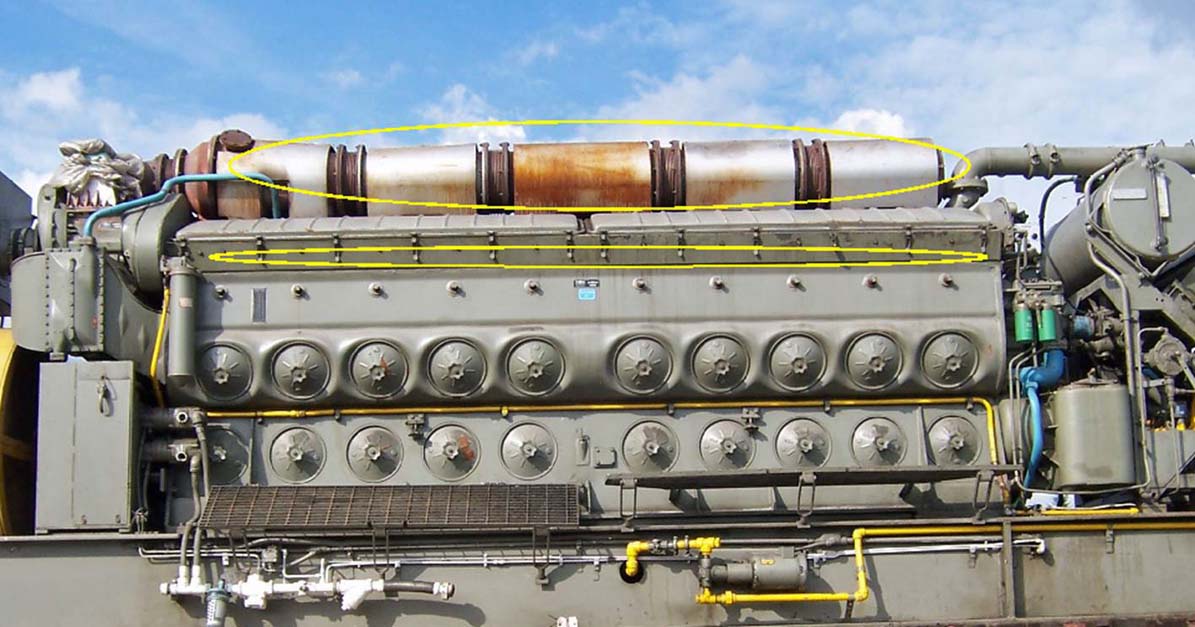 A typical General Motors V20 engine - Date? Andy Cassidy. This is a V20 power plant engine. The hot exhaust is still up top in the Vee (top oval), but the low pressure fuel lines and injector (that includes it's own HP integral pump) are all inside the top deck that is enclosed (bottom ellipse). Fuel leaks are generally drips that end up thinning the engine oil over time, and are detected through lube oil testing. 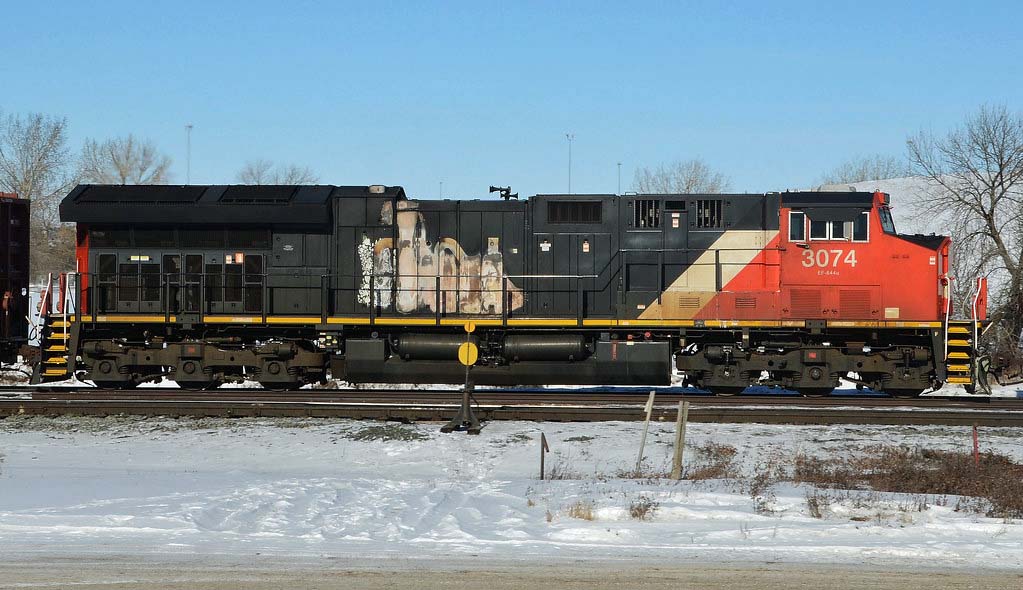 A Canadian National Toaster - 3 Mar 2019 Photographer?  Tree Windbreaks on C.P.R. Western Lines 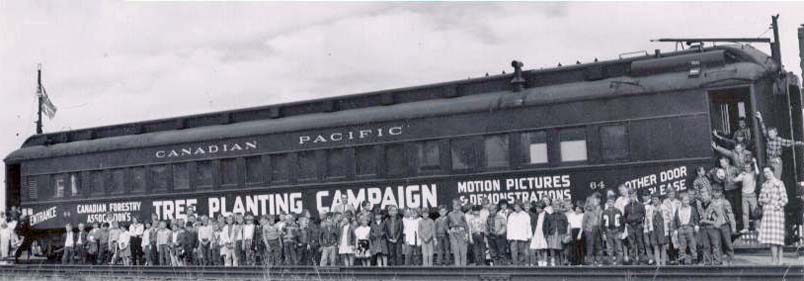 A Canadian Pacific Railway tree planting car - Date? Photographer? In response to a request for information in regard to the prices of tree windbreaks on the C.P.R. Western Lines, we are advised that the last two summers were exceedingly trying on trees on the prairie, particularly from Moose Jaw west, where the greater part of the company's windbreaks were planted. The hot winds, that swept the prairie during the dry spell, played havoc even with stock that had been well established and had survived many hard winters. In some cases entire plantations were killed back and what trees survived were severely checked in their growth and had to be cut back in order to give them a fresh start. Another feature in the destruction of trees is the panel and slab fence, which has to be maintained until the trees are sufficiently thick to hold the snow. This causes the snow to pile up, and in some cases to completely cover the trees, with the result that the young stock are badly shaken up when the snow thaws and settles in heavy masses in the spring. Of course tree windbreaks are most necessary on knolls and hills, where the track is in a cut. Trees so situated get less than the average amount of moisture, due to quick run off. For this reason trees along the right-of-way are at a greater disadvantage than they would be around a farm or on low lying ground. It is generally conceded by all who have tried tree planting on the prairie, that the windbreak must be of at least eight rows of trees, and that it must carry a percentage of dense shade giving, or close foliage, trees. The object of this is to reduce the amount of evaporation from the soil, bank the snow in the center of the plantation, and conserve needed moisture. It also reduces evaporation from the leaves in the hot dry spells. When the C.P.R. started this tree planting there had been no experiments carried on west of Moose Jaw, by either government or private individuals, consequently the company adopted the accepted planting practice of eastern Saskatchewan and Manitoba, and did not plant trees in sufficiently thick strips for territory farther west. When windbreaks have been planted east of Moose Jaw they have been decidedly satisfactory. Prairie farmers are beginning to realize how beneficial windbreaks are around their dwellings, and more so around the farms, where by repeated cultivation and ploughing, the soil is pulverized, and drifts from the heavy winds. This phase of tree windbreaks is receiving attention from the various farmers' organizations, which are advocating it very strongly in their meetings and through their press. Eastern Ontario - "The death knell has sounded", she wrote, and her statement extended well beyond the subject at hand. In 1978, the Canadian Pacific Railway's (CP) abandoned station at Apple Hill, Ontario, was demolished. Apple Hill station prior to its demolition - Date? Photographer? - Railway Museum of Eastern Ontario. The railway is, of course, still with us. The bridge over the South Nation River constructed by the Hamilton Bridge Works Company - Date? Photographer? - Dan Delong collection. This improvement of the line was finished in 1909 and increased the rail traffic capacity of the Winchester Subdivision. A harvest excursion train picks up farm labourers at the Avonmore station apparently. The women appear to too well-dressed for farm labourers - Date? Photographer? - Murray Barkley collection. The connection between rail and agriculture was magnified in importance at Finch, where the CP line was crossed by the north-south route of the New York & Ottawa Railway (NY&O) and turned the small community into an important transfer point for moving commodities throughout the region. Trackside spectators watching a westbound freight train pass the Avonmore station - Circa 1970 Photographer? - Railway Museum of Eastern Ontario. Merchants like Barkley's Store in Avonmore relied heavily on CP as a connection to urban industrial suppliers. Dismantling the freight shed at the Mountain station - Date? Photographer? - Railway Museum of Eastern Ontario. These combination stations consisted of a ground-floor waiting room and office, second-floor living quarters for the station agent and his family, and a freight and baggage shed extending off and along the platform to the side of the main building. Finch station and the interlocking tower next to it controlled the point where CP's double track was crossed by the single line of the New York & Ottawa Railway - Date? Photographer? - Railway Museum of Eastern Ontario. Station agents and telegraph operators were crucial railway employees in their time, responsible as they were for a constant flow of people, baggage, freight, and communications. The Finch station telegraph at the Chesterville and District Heritage Centre. It seems unusual a sounder is mounted beside the key as the proper location is in the wooden sound amplifying box on that cast metal swing arm - Date? Photographer? Modernized commerce and the automobile changed the character of local commerce and travel rapidly after World War Two, and revenue from railway passenger service plummeted through the 1950s. Aside from routine maintenance, the rail line running through this area is vacant geography for CP, the backdrop to larger rail operations carrying goods and commodities between ports and urban depots. 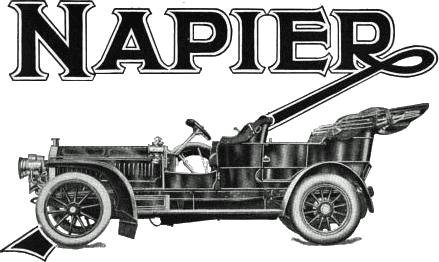 Charles Jasper Glidden Anonymous Author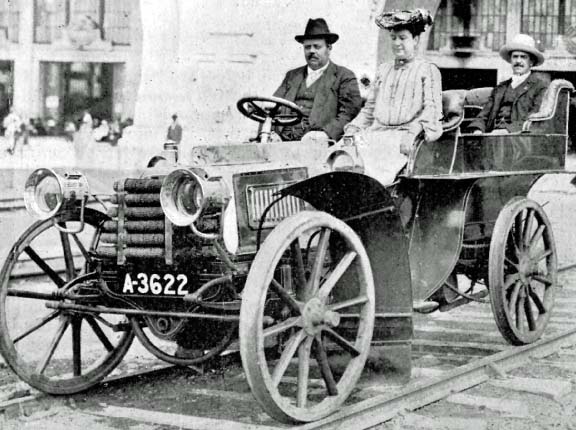 C.J. Glidden, his wife, and an unidentified rider pose for a photograph in a modified Napier Motor Car Company automobile - Circa 1904 Photographer? We're not talking about the paint company founder here... 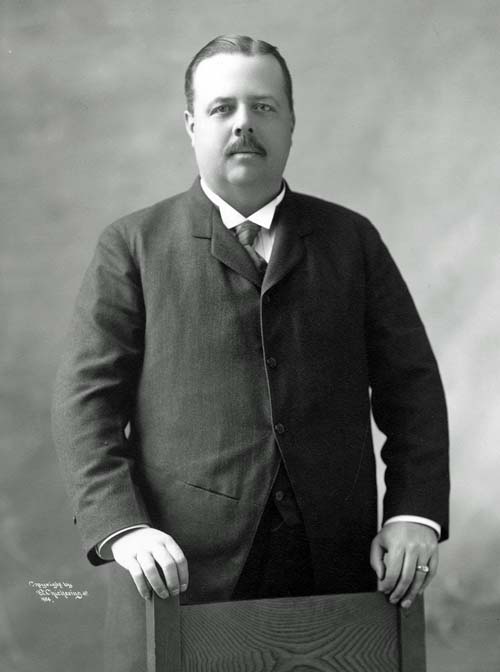 C.J. Glidden - 1904 G. Chickering - Vancouver Archives AM54-S4-: LP 17. At an early age Charles Jasper Glidden, managing a telegraph company, came into contact with Alexander Graham Bell who was experimenting with a telephone connected to telegraph lines. Gliddens expertise grew Bell's telephone/telegraph into a company selling subscriptions across several states. Glidden eventually sold out to Bell in 1901 making Glidden wealthy enough to purchase several cars to facilitate his passion for the automobile. He believed the newly invented automobile required a road system, so he would spend the rest of his live promoting the car by taking it to places in the world that had never even seen a car at that time. He toured many American States and countries with his cars, and was the first to circle the world by automobile... which he did twice! His fascination with the automobile evolved into the annual Glidden Reliability Tour between 1905 and 1913 in which he donated a silver trophy and a cash prize of US$2,000 to the winner each year (US$2,000 in 1905 would be worth US$59,154 today). The Napier Motor Company of America began producing cars about 1904, being partially manufactured in England and America, until the company's demise in 1911. Glidden was enamored of the Napier and bought several. One in particular was fitted out with flanged wheels so it could run along railway tracks. In September of 1904 he and his wife travelled between Minneapolis, Minnesota, and Vancouver, British Columbia, over the SOO Line and then the Canadian Pacific Railway. This tour was apparently promoted as being the first car to cross the Rocky Mountains. Photographs from the City of Vancouver Archives show the Glidden's greeted by a large crowd upon their arrival at Canadian Pacific's second Vancouver station (Waterfront) by Coal Harbour. Glidden Reliability Tours continued until 1913 when interest waned. In 1946 the Glidden Tour was restarted by the Veteran Motor Car Club of America, renamed the Vintage Motor Car Club of America in 2017, it still presents tour winners with that original Glidden trophy of 1905. Related Links Glidden Tour Photos - Detroit Public Library Glidden Tour Photos - Michigan State University Vintage Motor Car Club of America |

